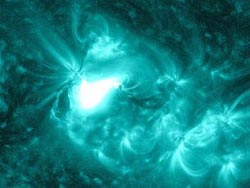New solar active region spitting out flares

The Solar Dynamics Observatory captured this image of an M1.2 class flare on June 13, 2012. The sun is shown here in teal as this is the color typically used to represent light in the 131 Angstrom wavelength, a wavelength particularly good for observing flares. Credit: Credit: NASA/SDO<br>
The region fired off two M-class flares and two coronal mass ejections (CMEs) on June 13 and June 14, 2012. The first flare lasted for a relatively long three hours, peaking on June 13, 2012 at 9:17 AM EDT. The associated CME traveled at approximately 375 miles per second and is directed toward Earth, though due to its slow speed, the effect on Earth is expected to be minimal.
The second M-class flare was also a long-duration flare, and it peaked on June 14, 2012 at 10:08 AM EDT. The CME associated with this flare is traveling much faster – preliminary analysis at Goddard's Space Weather Center indicates it is traveling at speeds of approximately 800 miles per second. It is traveling toward Earth, and could also impact Mars and the Spitzer spacecraft.
The Space Weather Center models estimate that both CMEs will arrive on June 16.
We will provide updates if AR1504 generates additional space weather.
Media Contact
More Information:
http://www.nasa.govAll latest news from the category: Physics and Astronomy
This area deals with the fundamental laws and building blocks of nature and how they interact, the properties and the behavior of matter, and research into space and time and their structures.
innovations-report provides in-depth reports and articles on subjects such as astrophysics, laser technologies, nuclear, quantum, particle and solid-state physics, nanotechnologies, planetary research and findings (Mars, Venus) and developments related to the Hubble Telescope.
Newest articles

Superradiant atoms could push the boundaries of how precisely time can be measured
Superradiant atoms can help us measure time more precisely than ever. In a new study, researchers from the University of Copenhagen present a new method for measuring the time interval,…

Ion thermoelectric conversion devices for near room temperature
The electrode sheet of the thermoelectric device consists of ionic hydrogel, which is sandwiched between the electrodes to form, and the Prussian blue on the electrode undergoes a redox reaction…

Zap Energy achieves 37-million-degree temperatures in a compact device
New publication reports record electron temperatures for a small-scale, sheared-flow-stabilized Z-pinch fusion device. In the nine decades since humans first produced fusion reactions, only a few fusion technologies have demonstrated…





















